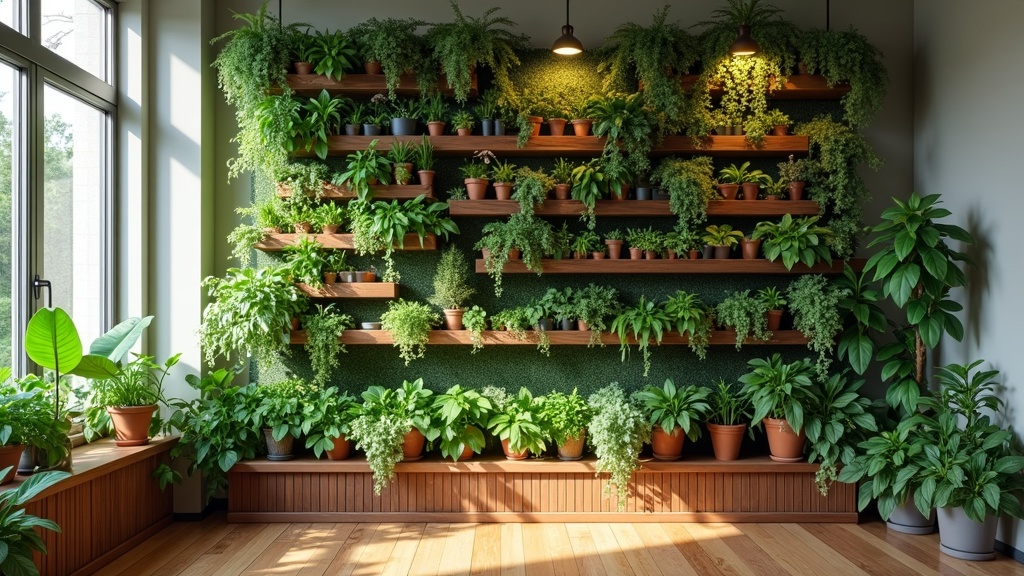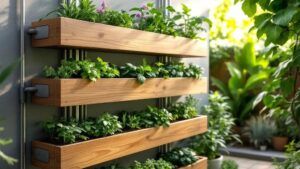If you’re looking to bring a pop of green into your apartment or house, a vertical garden is a pretty clever way to do it—even if you’re short on space. Growing plants upward instead of outward means you won’t need a fancy backyard or even much extra floor area. On top of that, an indoor vertical garden brings fresher air and lots of style to any corner of your home.

What Is a Vertical Garden (and Why Try It at Home)?
Vertical gardens, sometimes called living walls or green walls, use walls or vertical structures to hold plants and growing medium. They turn boring walls into lively, leafy displays. You’ll spot these in office spaces, restaurants, and more, but doing it at home is completely doable with the right know-how.
Bringing a little green inside goes beyond just looks. Plants help with air quality and boost mood. If you’re working from home or staring at screens all day, a patch of greenery nearby can give your space a much more relaxed vibe. Plus, if you pick edibles like basil or lettuce, you can harvest fresh produce without heading outside. Some folks even stumble upon a new hobby or passion when they set up their first indoor vertical garden, and kids love keeping track of how everything grows and changes through the seasons.
Choosing the Right Spot for Your Indoor Vertical Garden
The first thing to figure out is where your garden should go. Light is a big deal for most indoor plants. A spot by a window with bright, indirect sunlight usually works best for a range of houseplants. If your place doesn’t get a ton of sunlight, no worries; there are plenty of low-light plants or simple LED grow lights that keep things growing.
- Look for: An open wall close to natural light, like near a south or east-facing window.
- Avoid: Places with extreme temperature swings, such as next to radiators, AC units, or entryways.
- Think about water: Make sure you can water the plants easily without big messes or spills.
Sometimes, finding the ideal location takes a bit of experimenting, especially if you want to set up your green wall in an unusual space like a hallway or above a home office desk. As you check out potential spots, pick up on how much sunlight comes through during the day and track down any heating vents or drafty corners that could affect plant health.
Picking the Best Plants for Your Space
Choosing plants is a fun part and super important for how well your vertical garden does. I like to mix things up for more texture and interest.
- Lowmaintenance picks: Pothos, snake plant, and spider plant. These tolerate some neglect if you’re forgetful with watering.
- For a lush look: Ferns, philodendrons, and peace lilies pack in leafy fullness quickly.
- For herbs and edibles: Basil, mint, parsley, and lettuce do well inside when they get good light.
- Keep an eye out for water drippers: Some ferns and certain houseplants can get messy if you’re not careful. Make sure your setup can handle extra moisture.
If you want something nextlevel cool, try mixing in air plants (tillandsias) which don’t need soil and can be tucked into cracks or attached to wood. Succulents are another userfriendly option for sun-filled rooms, and give your garden a unique look. If you’re after more color, think about adding flowering plants like African violets or small orchids, as long as your lighting is right.
Types of Indoor Vertical Garden Systems
A vertical garden isn’t just one specific product. It’s a whole category of setups. Here are some easy types people usually try at home:
- Wall planters: These are modular pockets or shelves you can attach right to your wall. Felt pockets, wooden boxes, or plastic pouches are all fair game.
- Hanging systems: Macrame plant hangers, rails with suspending pots, or even old shoe organizers can work for trailing plants.
- Trellis and grid systems: These make it easy to clip or hook pots directly to a wire or wooden frame. It’s handy for renters since you only need a couple of secure hooks.
- DIY upcycled options: Old pallets, bookshelves, or spice racks can be repurposed into custom garden setups.
Some folks even put together movable vertical gardens using rolling carts or ladder shelves, so they can move the garden from room to room depending on light and season. This trick is perfect for urban apartments or rental spaces where you can’t drill into the walls.
StepByStep Guide to Building Your Indoor Vertical Garden
- Pick your spot and measure up: Make sure the area you want to use is big enough for your planned arrangement.
- Choose your system: Decide if you want readymade panels or to DIY with upcycled shelves or organizers.
- Set up your support: For wall planters, use wall anchors or sturdy hooks. For trellis systems, secure them according to weight and wall type.
- Add your containers and growing medium: Felt pocket panels take soil directly; pots or mason jars need drainage materials like gravel before soil. If using hydroponics, doublecheck the reservoirs and pumps are set up right.
- Arrange your plants: Put the sunlovers near the top, since more light usually hits the upper levels, and keep the shadetolerant picks on the lower rows.
- Water and watch: The first couple of weeks are for figuring out your garden’s routine. Check for dry soil, dripping water, or wilting plants, and adjust as needed.
Remember, the process can be as creative as you like. Some gardeners sketch out designs before buying plants, while others mix it up on the fly. You can even put together symmetrical patterns or zigzag arrangements for added visual pop.
Watering and Care Tips for Vertical Gardens
Watering is a little different when your plants are going up instead of across. Gravity draws water down, so the top layers often dry out sooner than the bottom. Here’s how to keep everything happy:
- Check soil moisture often: The upper rows usually need more frequent watering. I stick my finger in or use a moisture meter to check a few spots.
- Use a spray bottle or narrowspout watering can: This helps minimize spills, especially on higher rows or behind leaves.
- Catch excess runoff: Place a tray or waterproof mat underneath, or choose setups with builtin trays to keep your floor protected.
- Trim and tidy: Pinch back dead leaves, and rotate plants if they look uneven. This helps keep growth even and the garden looking sharp.
Feeding your plants every few weeks with diluted liquid fertilizer gives a boost to growth and leaf color. Also, dusting leaves or rinsing them with a gentle spray keeps your garden looking fresh and helps plants photosynthesize better.
Common Challenges and How to Tackle Them
- Dealing with low light: If natural sunlight is an issue, LED grow lights can fill the gap. Just clip them above or alongside the garden. I’ve found fullspectrum lights help herbs and indoor flowers keep thriving, even in darker months.
- Overwatering or underwatering: It’s easy to go overboard or forget, especially with multiple containers. Selfwatering planters or adding perlite to the soil can help balance things out.
- Wall damage: Sometimes moisture can build up between the wall and your planter. Use a waterproof backing, or leave a small air gap between the wall and the system to prevent mold or stains.
- Pests: Like any indoor garden, you might get the occasional bug. Give new plants a quick rinse before adding, and wipe leaves if dust or tiny pests show up.
Watering Consistency
Consistency is really important for these gardens since small pots dry out quickly. I keep a watering schedule and check my plants every couple days. Setting a phone reminder works wonders if you’re forgetful (like me sometimes!).
Preventing Wall Damage
Any time you combine moisture and walls, a little planning can save you headaches. Choose panels or systems with builtin waterproof layers, or put a sheet of plastic behind your setup. If you rent, wallsafe hooks or freestanding racks save you repairs when it’s time to move.

Managing Pests
Keep an eye out for things like fungus gnats and spider mites—these pop up in moist environments. Wipe leaves, avoid letting water sit on topsoil, and grab sticky traps if tiny bugs show up. If you spot a bigger issue, consider using natural pest repellents or mild soap sprays to keep things under control without harming your plants.
Adding Style to Your Living Wall
An indoor vertical garden can be a creative piece of decor. Mixing plant heights, leaf shapes, and pot colors gives it real personality. I like to add a few colorful pots mixed in with plain ones for a fun contrast. If you’re into DIY, painting or decorating shelves or frame edges helps your garden blend with your room’s style.
- Shelf lighting or string fairy lights can up the cozy factor, especially at night.
- Pair herbs near the kitchen for a handy and goodlooking spice rack.
If you want your setup to look even more nextlevel cool, add mirrors or metallic accents behind your garden to reflect greenery and light. Wall art or decorative hooks can tie your living wall into the rest of your space, making it a true feature rather than just a collection of pots.
Frequently Asked Questions
Here are some things people usually want to know before getting started:
What’s the easiest plant to grow in a vertical garden indoors?
Bamboo palm, pothos, and philodendron are all pretty forgiving for beginners.
Do I need special soil for a vertical setup?
Regular highquality potting mix is just fine for most houseplants. Adding some perlite or coco coir helps with drainage if the setup is tight.
How do I stop my wall from getting moldy?
Try a setup that stays a few inches away from the wall and check for excess water after every few waterings. Waterproof panels or a plastic barrier behind the garden help too.
What’s the best way to fertilize a vertical garden?
Mix a diluted liquid fertilizer into your water every two to three weeks during active growth seasons. Be careful not to overfeed—too much fertilizer can build up in small planters and hurt your plants.
Bringing It All Together
Setting up a vertical garden at home adds real, living beauty to any space, even if you’re dealing with apartment walls or tiny rooms. The setup can be as small and simple or big and bold as you want. Start with a sturdy support, pick the right plants for your lighting, and keep up on watering and trimming, and you’ll have a growing living wall that fits right into your everyday life. If you’re keen to see more tips or specific DIY ideas, there’s plenty of inspiration in houseplant forums and gardening apps. Whether you want a six-foot lush backdrop or a pintsize kitchen herb wall, it’s all about finding a setup that matches your lifestyle and space. Gardens keep evolving with you, so you can always mix it up, adjust your design, and keep things green and lively for years to come.
